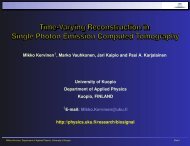USER'S GUIDE - Biosignal Analysis and Medical Imaging Group
USER'S GUIDE - Biosignal Analysis and Medical Imaging Group
USER'S GUIDE - Biosignal Analysis and Medical Imaging Group
- No tags were found...
Create successful ePaper yourself
Turn your PDF publications into a flip-book with our unique Google optimized e-Paper software.
2.3. Preprocessing of HRV time series 20amount of artifact-free data is insufficient, proper interpolation methods can be used toreduce these artifacts, see, e.g., [21, 22, 29].Another common feature that can alter the analysis significantly are the slow linearor more complex trends within the analyzed time series. Such slow nonstationarities arecharacteristic for HRV signals <strong>and</strong> should be considered before the analysis. The origins ofnonstationarities in HRV are discussed, e.g., in [3]. Two kinds of methods have been usedto get around the nonstationarity problem. In [48], it was suggested that HRV data shouldbe systematically tested for nonstationarities <strong>and</strong> that only stationary segments should beanalyzed. Representativeness of these segments in comparison with the whole HRV signalwas, however, questioned in [14]. Other methods try to remove the slow nonstationary trendsfrom the HRV signal before analysis. The detrending is usually based on first order [23, 31]or higher order polynomial [39, 31] models. In addition, this software includes an advanceddetrending procedure originally presented in [43]. This approach is based on smoothnesspriors regularization.2.3.1 Smoothness priors based detrending approachLet z ∈ R N denote the RR interval time series which can be considered to consist of twocomponentsz = z stat + z trend (2.1)where z stat is the nearly stationary RR interval series of interest, z trend is the low frequencyaperiodic trend component, <strong>and</strong> N is the number of RR intervals. Suppose that the trendcomponent can be modeled with a linear observation model asz trend = Hθ + e (2.2)where H ∈ R N×p is the observation matrix, θ ∈ R p are the regression parameters, <strong>and</strong> e isthe observation error. The task is then to estimate the parameters by some fitting procedureso that ẑ trend = H ˆθ can be used as the estimate of the trend. The properties of the estimatedepend strongly on the properties of the basis vectors (columns of the matrix H) inthefitting. A widely used method for the solution of the estimate ˆθ is the least squares method.However, a more general approach for the estimation of ˆθ is used here. That is, the so-calledregularized least squares solution{ˆθ λ =argmin ‖z − Hθ‖ 2 + λ 2 ‖D d (Hθ)‖ 2} (2.3)θwhere λ is the regularization parameter <strong>and</strong> D d indicates the discrete approximation of thed’th derivative operator. This is clearly a modification of the ordinary least squares solutionto the direction in which the side norm ‖D d (Hθ)‖ gets smaller. In this way, prior informationabout the predicted trend Hθ can be implemented to the estimation. The solution of (2.3)canbewrittenintheformˆθ λ =(H T H + λ 2 H T D T d D dH) −1 H T z (2.4)<strong>and</strong> the estimate for the trend which is to be removed asẑ trend = H ˆθ λ . (2.5)The selection of the observation matrix H can be implemented according to some knownproperties of the data z. For example, a generic set of Gaussian shaped functions or sigmoidscan be used. Here, however, the trivial choice of identity matrix H = I ∈ R N×N is used. InKubios HRV <strong>Analysis</strong>version 2.0 beta<strong>Biosignal</strong> <strong>Analysis</strong> <strong>and</strong> <strong>Medical</strong> <strong>Imaging</strong> <strong>Group</strong>Department of PhysicsUniversity of Kuopio, FINLAND





